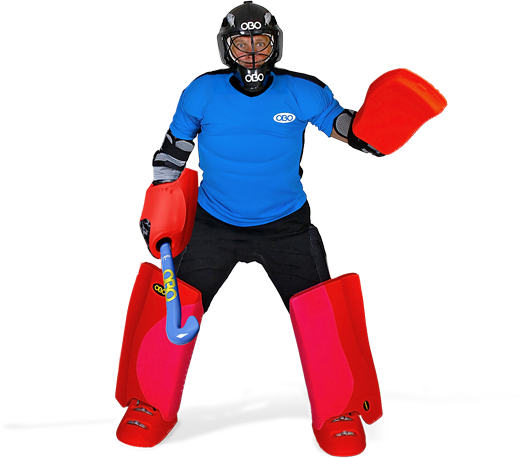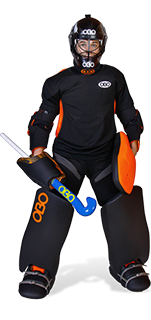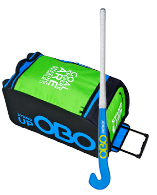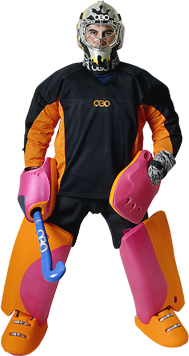KEEPERS RESOURCES

Kicking
There is no more essential skill to a keeper in the game of hockey, than kicking. Just as a field player must have stick skills, a keeper must have kicking skills. The importance of this most basic of skills is often overlooked. People tend to think all a keeper need do is worry about saving the ball. A keeper can make all the saves in the world in a game, but if he can’t clear the ball, he almost assures himself of allowing goals.
Typically most practices for a keeper centre around stopping shots on goal. He is presented with some forwards, about thirty balls and faced with various exercises designed to do nothing more than test his reflexes. Stop one shot; move on to the next. It is essential that keepers get in his mind set that a save is not completed until the ball is safely cleared to a defender or out over the side line. Think about the situations in a game that can require a keeper to play a ball with his feet. Loose balls in the circle, passes in the goal area, shots in the circle and back passes from his defenders are all opportunities for keepers to create positive ball possession for his team-mates.
Kicking is an active skill that incorporates many techniques. Note the word active. Kicking is not simply allowing the ball to hit your foot and redirect. It can be, especially on hard shots, but in most cases, it involves a keeper stepping up to interject himself into a situation and playing the ball.
Kicking is controlling the ball. For the sake of this piece, we’re only going to discuss one type of kicker, high-density foam. On high-density foam kickers, the area of greatest control is located on the instep, between the ankle and the round of the foot. If a keeper is looking to play the ball with his foot for maximum control, instep is the way to go. The type of ball you’re dealing with, obviously impacts the technique a keeper has available to him to kick the ball with his instep.
For shots that are basically straight at a keeper (surprisingly they constitute a large percentage of the balls a keeper faces), he is stepping in to play the ball, rather than waiting for the ball to come to him. The kick starts from a good ready position, with the keeper up on the balls of his feet. The mechanic starts with the keeper opening the foot/instep of his kicking leg up to the angle that he wants to clear to. He is pushing off from his non-kicking leg. As he goes forward, he leads with his head, then his chest. If a keeper does this, the knee of his kicking leg should be in a straight line up from his foot when he makes contact with the ball. As he contacts the ball, the follow through of his kick should carry on to the line of the clear. Assuming he does all this, the results should be a low, hard, clear to target.
Common problems for keepers with kicking seem to come from relatively few areas. They range from kicks rising, to inaccuracies, to little or no power. One at a time, these are the things to look for:
Rising balls – start on the balls of your feet. Get on to the line of the ball early. Open up the instep of your kicking foot. Push forward off your non-kicking leg. Get your head out in front of your body. Kick through with your kicking foot towards your target.
If you don’t push off with your non-kicking leg, your head goes back, which results in a keeper making contact with ball with his foot in an angle in front of his knee. Think about your foot as a golf club, and in this position your foot is a 9 iron.
Inaccuracies – When a keeper has problems with accuracy, they usually stem from him not getting on to the line of the ball early enough. There is a lot of footwork in getting your body in to a position where you can kick to your desired target. It’s a lot of short quick steps, very similar to how a tennis player moves. A keeper will also have trouble kicking to his target if he doesn’t open up his body to change the angle. If a keeper doesn’t change the angle of his body with a straight on shot, an instep clear will go directly back to the shooter. That’s a bad thing.
A keeper needs to open up his stance to change the angle of the ball. It starts with him opening up his shoulder, then his hip, then his instep on his kicking side. Opening up will give him a slight back swing as he steps for his last “prep step” before performing the kick (we’ll call the steps you take to set up performing a skill as “prep steps”). The downswing on the kick should be in as direct a line as possible, along the line of where you want the ball to go (i.e. towards your target).
Keepers also have problems with accuracy when they don’t open up their instep up early enough to the ball, or take it on their foot between the ankle and the round of the foot. When a keeper doesn’t open up early enough he ends up twisting his foot as he is kicking. He can’t get any follow through. Unless you take the ball on the sweet spot of the kicker, you’re making contact with a rounded surface at either your heel or your toe.
No Power – problems with power often come from the plant. If your plant leg is too far away when you kick the ball, you have to reach with your kicking foot getting out in front of the knee at contact. This causes you to basically kick with the bottom of your foot, as opposed to your kicker. Unless you have high-density foam on the bottom of your shoes, you’re going to have a problem getting power. Follow through adds power to kicks and the only way to get is to be able push off with your plant leg and kick through the ball.
Good luck,
Jon
e-mail Jon
Please note that OBO together with Jon O’Haire hold copyright over any material appearing on tips pages. We welcome the printing and distribution of these tips, provided that they are not sold, or used for financial gain. This paragraph must appear on all printed or distributed copies. The photographs above must not be used in any form without express permission from Jon O’Haire.
Comments
Leave Your Comments Below















